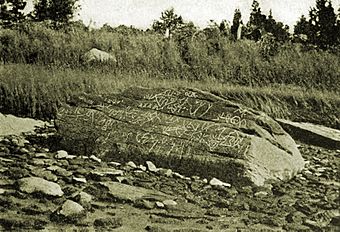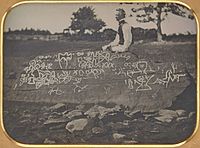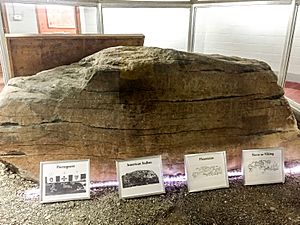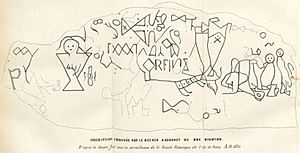Dighton Rock facts for kids
Quick facts for kids |
|
|
Dighton Rock
|
|
 |
|
| Location | Berkley, Massachusetts |
|---|---|
| Nearest city | Dighton, Massachusetts |
| Built | 1964 |
| NRHP reference No. | 80000438 |
| Added to NRHP | July 1, 1980 |
The Dighton Rock is a huge, heavy stone that used to sit in the Taunton River in Berkley, Massachusetts. It's famous for its mysterious carvings, called petroglyphs. These designs are very old. No one is completely sure who made them or what they mean.
In 1963, the rock was moved from the river. It was placed in a museum at Dighton Rock State Park to protect it. The Dighton Rock was added to the National Register of Historic Places in 1971.
Contents
What Dighton Rock Looks Like
The Dighton Rock is shaped like a slanted, six-sided block. It's about 5 feet (1.5 meters) tall. It is also 9.5 feet (2.9 meters) wide and 11 feet (3.4 meters) long. The rock is a gray-brown sandstone.
The side with the carvings is shaped like a trapezoid. It slants at a 70-degree angle. This side used to face the water of the bay.
Mysteries of Dighton Rock's Carvings
The Dighton Rock has been a mystery for a long time. Many people have wondered who made the carvings. They also wonder what the carvings mean.
Early Discoveries and Descriptions
In 1680, an English settler named Rev. John Danforth drew the carvings. His drawing is now in the British Museum. But his drawing looks different from what others saw later.
In 1690, Rev. Cotton Mather wrote about the rock. He described it as a "mighty Rock" with "strange Characters." He said the carvings were "deeply Engraved." This made people wonder about who lived there before them.
Later, in the 1800s, many writers talked about the rock. The writer James Russell Lowell even joked about it. He suggested that politicians should mention the Dighton Rock in their letters. This helped make the rock even more famous.
Who Made the Carvings?
Many ideas have been suggested about who created the mysterious carvings. Here are some of the main theories:
- Indigenous Peoples
- Many believe that Native Americans made the carvings. They were known to create petroglyphs on rocks. A face carved on Dighton Rock looks like other Native American carvings. This idea was first suggested in 1783 by Ezra Stiles.
- Norse Explorers
- Some people think Norsemen (Vikings) carved the rock. This idea came up in 1837 from Carl Christian Rafn. However, many archaeologists do not agree with this theory.
- Portuguese Explorers
- In 1912, Edmund B. Delabarre suggested that Portuguese explorers made some carvings. He thought they added their own writing to the rock. Delabarre believed the carvings meant: "I, Miguel Cortereal, 1511. In this place, by the will of God, I became a chief of the Indians." But experts like Hunter (2017) have shown that this idea is likely not true.
- Chinese Explorers
- In 2002, Gavin Menzies wrote a book called 1421: The Year China Discovered America. In it, he suggested that Chinese explorers might have carved the rock.
Dighton Rock State Park
In 1952, a group wanted to create a park near the rock. They bought land for this purpose. However, the state of Massachusetts also wanted to make a park there.
In 1951, the Massachusetts government took over the land for a State Park. More land was bought later. Now, Dighton Rock State Park is about 100 acres (400,000 square meters). The park has been made nice for visitors. It has parking and picnic areas.
How Deep Are the Carvings?
Cotton Mather said the carvings were "deeply engraved." But early reports said this wasn't quite true. In 1730, Greenwood said the carvings were "not very considerable." He meant they were not very deep.
It has always been hard to see the real carvings clearly. Even in the past, people had trouble making them out. Some parts of the rock show a lot of wear. But even those parts were hard for early observers to understand.
Later, in 1768 and 1807, others said that most of the lines were so worn away. This made it impossible to figure out what they meant. They said it was mostly up to what you imagined.






